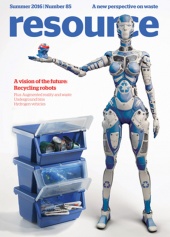Three examples of resource efficient design of everyday products
Eight per cent of a product's environmental impact is determined during its design, meaning that by the time the blueprints for your new washing machine, bookcase, car, or phone have been completed, the amount of material that can be recovered from it for reuse, remanufacture or repair has been pretty much predetermined.
For Resource 85, we took an in-depth look at how design is being used to cut down on waste and bring in a more circular economy, where products are created to have more than one life. Here are three examples of products that are already putting the concept of ecodesign into practice.
The Do chair
Office furniture manufacturer Orangebox’s ‘Do’ chair was designed to be ergonomic and user friendly, but also sustainable. Made entirely from recyclable (and, where possible, recycled) materials, the chair was designed for disassembly, with the seat, arms and back fabric simply clipping on and off to make repair and remanufacture simpler.
The number of materials was also reduced with markings designed in to identify the material type and facilitate recycling. Orangebox also worked with its supply chain, using local suppliers wherever possible and taking steps to drive its approach along the chain.
Kingfisher drill
Many power tools have components that are extremely durable and not subject to technological advances, but tend to get thrown away with the rest of the tool when more sensitive parts break. Along with Brunel University, DIY retailer Kingfisher has developed a cordless drill that can be disassembled in under a minute to keep working parts in the loop and to remove faulty parts that can be shipped back to the manufacturer to be completely recovered.
 This article was taken from Issue 85
This article was taken from Issue 85
The Optimist toaster
After finding that people are reluctant to take small appliances to their local recycling centre, the Agency of Design decided to make a toaster that would never need to be disposed of. Rather than popping mechanisms that can fail, its Optimist toaster has a rotating arm with few moving parts.
The base can be removed, with all components popping in and out and every component is made out of highly recyclable aluminium, starting out with 100 per cent recycled content. To celebrate the product’s longevity, it even has a ‘toastometer’ that clicks round every time a new slice is cooked.
The Optimist was one of three differnet toasters designed to remove waste from the daily breakfast. The Pragmatist is a modular toaster, where individual toasting slots join together to form an exandable toaster that can also be dismanlted to send single broken parts to the producer for repair, while The Realist looked at the end of life process and was made to disassemble as easily as possible by placing expanding pellets next to snap fit joints.







